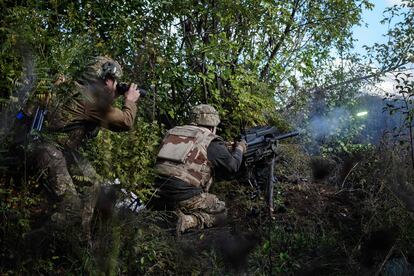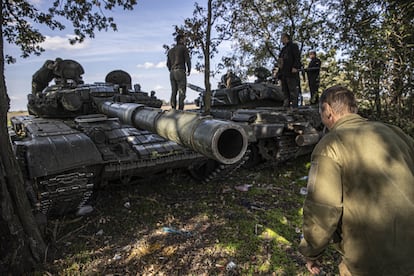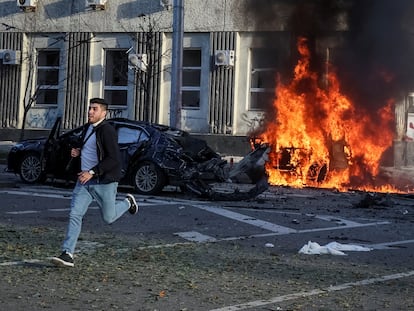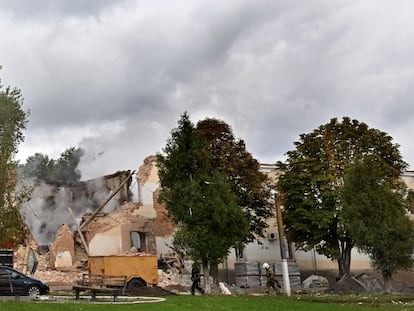Ukraine turning the tide of Russia war as defense turns to attack
Kyiv’s successful counter-offensive combines battlefield experience, use of NATO tactics, higher motivation and better conditions than Russian forces

The war in Ukraine has served to highlight the shortcomings of Russian might, but it has also provided a guide for turning an underpowered and outnumbered army into one capable of taking on a military colossus in record time. “NATO’s support is important, of course, but none of its member states have ever taken on a power like Russia on the battlefield,” says Ukrainian army captain Victor Tregubov. Ukraine’s armed forces have expelled Moscow’s invading army from Kharkiv and they have forced Russian troops to retreat in the eastern Donbas region and Kherson in the south. Kyiv’s troops had already proven themselves adept in defensive strategy; now they are showing that they also have sound tactics when going on the offensive.
The basis of Ukraine’s successes during recent counter-offensives is that its troops are better trained and its units more coherent, according to experts consulted by EL PAÍS. The protests in Russia after Vladimir Putin ordered a partial mobilization of the country provide another of the most basic reasons for the momentum shift on the ground in Ukraine: the motivation of a volunteer army defending their homeland will always be greater than that of a partially conscripted force invading another country. “For Ukraine’s soldiers it is clear what is at stake; protecting their homes and families and preventing their country from being wiped off the map,” says Mykhailo Samus, director of the New Geopolitics Research Network think tank. “But for these Russian conscripts it is difficult to understand why they have to die in Ukraine.”
Moscow was mistaken from the outset if it thought it was facing the same Ukrainian military as in 2014, notes Samus. At that time, when the Kremlin annexed Crimea and provided support for an insurgency of pro-Russian separatists in Donbas, the Ukrainian army consisted of a few thousand regular troops and was severely underfunded. Viktor Yanukovych, the pro-Russian president of Ukraine from 2010 to 2014 who was ousted during the Maidan uprising, reduced the country’s defensive capacity by applying the doctrine that Ukraine should serve as a neutral buffer between Russia and the West. However, the Donbas conflict witnessed the birth of the armed forces of Ukraine, mainly through the raising of volunteer battalions.
That army of 2014 and the Ukrainian military of 2022 are incomparable in reality, says Captain Tregubov. “The Russians seem to have gone backward. If you look at images from the annexation of Crimea, they look like a modern army, and we look like a ragged bunch. Now it’s the other way around, their equipment is from another era.” Tregubov provides a simple yet vital example. When he served in Donbas in 2015, he was handed a pair of old Soviet boots that destroyed his feet. Now, he wears the finest military boots available in Europe. “Our uniforms and equipment today meet NATO standards,” says Vlad, a 24-year-old soldier on the front line with the 24th Mechanized Brigade, who spoke to EL PAÍS on condition of anonymity. “Every unit in our regiment has thermal scopes, NLAW anti-tank missile launchers or grenade launchers: it wasn’t like this before.”
“The technological level that Ukrainian troops have reached is important, even in the smallest details. Every unit works with computers and has other quality IT devices thanks to donation campaigns, and they can adapt civilian technology to their military operations in a creative way,” says Olha Husieva, a researcher at the Institute for Security Policy at the University of Kiel in Germany.
EL PAÍS was able to witness first hand the civilian contribution to the war effort on the front between Dnipro and Kherson in July. Every Ukrainian position in the area had a shared application developed by software engineers that provided up-to-the-minute information on the location and identity of the enemy units facing them, even describing the terrain they were in and what weapons they were in range of.
Financial support
While Ukrainian technology outstrips that available to the Russian army with civilian help, the financial support provided by the Ministry of Defense is equally important. Almost half of Ukraine’s annual state budget is allocated to the war, something made possible by the economic aid of its allies, primarily Europe and the United States. The member states of the European Union have pledged €28 billion to Ukraine, according to the Kiel Institute for the World Economy (IfW). The US has currently committed to providing €15.2 billion and the UK €2.5 billion, according to the IfW.
Ukrainian President Volodymyr Zelenskiy has said that the main priority is to guarantee the provision of supplies and equipment for the armed forces, and the salaries of personnel. The latter have skyrocketed during the war, from around €1,100 previously to €3,400 for combat troops and €2,000 for support units. Front line personnel also get paid bonuses for destroying Russian hardware: taking out a tank, for example, is worth €1,400.
Although salaries among Russian troops may not differ much, Husieva says that the IfW calculates that the average income among Kremlin forces does not exceed €700 per month. “What is even more decisive is that we have information that there are delays in payments to Russian troops. That increases discontent, which is not the case on the Ukrainian side.”

The NATO factor
For Samus, Zelenskiy’s decision to replace many of the top brass of the General Staff when he came to power in 2020 was equally decisive, paving the way for younger officers who have moved on from the rigid legacy of Soviet military doctrine. “All of the generals and regimental commanders have received NATO training,” he says. From Commander-in-Chief of the Armed Forces of Ukraine, Valerii Zaluzhnyi, to 29-year-old Colonel Serhii Shatalov, who commands one of the most important tactical battalions on the Kherson front, every high- and medium-ranking officer has studied NATO tactics. There are also hundreds of Ukrainian officers currently training with the forces of NATO member countries in preparation for strategic responsibilities on the front lines.
Another major difference between the two armies, according to experts consulted, is that unlike the unbendable Russian military hierarchy, inherited from the Soviet model, the Ukrainian military encourages independent decision-making and autonomy among unit commanders on the ground. “Decisions are more agile,” says Husieva, “and attacks are made using a hit-and-run strategy; they never directly take on the enemy and they operate in sections of five to 10 soldiers.” Using this tactic, Ukrainian forces were able to break Russian lines in various sectors on the Kharkiv and Donbas fronts.
But perhaps most important of all is battlefield experience, and the armed forces of Ukraine have been fighting pro-Russian separatists in Donbas for eight years. Samus estimates there are 50,000 veterans of the Donbas conflict currently in active service, providing the backbone of the Ukrainian military and helping to train new recruits in the front lines. In total, taking into account reservists and the National Guard, the Ukrainian military currently has around 700,000 available personnel. “The Russians do not have this weight of accumulated experience,” says Samus. “And those who do have it have not returned.”
“In all these months of war, we have become accustomed to fighting under their artillery,” adds Captain Tregubov. “The new Russian recruits haven’t experienced any of this yet. I think that when they get to the front, they are going to be very frightened.”
Tu suscripción se está usando en otro dispositivo
¿Quieres añadir otro usuario a tu suscripción?
Si continúas leyendo en este dispositivo, no se podrá leer en el otro.
FlechaTu suscripción se está usando en otro dispositivo y solo puedes acceder a EL PAÍS desde un dispositivo a la vez.
Si quieres compartir tu cuenta, cambia tu suscripción a la modalidad Premium, así podrás añadir otro usuario. Cada uno accederá con su propia cuenta de email, lo que os permitirá personalizar vuestra experiencia en EL PAÍS.
¿Tienes una suscripción de empresa? Accede aquí para contratar más cuentas.
En el caso de no saber quién está usando tu cuenta, te recomendamos cambiar tu contraseña aquí.
Si decides continuar compartiendo tu cuenta, este mensaje se mostrará en tu dispositivo y en el de la otra persona que está usando tu cuenta de forma indefinida, afectando a tu experiencia de lectura. Puedes consultar aquí los términos y condiciones de la suscripción digital.
More information

Fear returns to the streets of Kyiv following Russian strikes
Últimas noticias
Maduro pleads not guilty before the federal court in New York: ‘I am still the president of Venezuela’
A new test can detect Alzheimer’s from a finger prick
UN team enters Sudanese city of El Fasher after paramilitary massacre: ‘It’s like a ghost town’
A recipe for resistance: Indigenous peoples politicize their struggles from the kitchen
Most viewed
- Gilles Lipovetsky: ‘If you want to live better and fall in love, take Prozac, don’t look to philosophy’
- Alain Aspect, Nobel laureate in physics: ‘Einstein was so smart that he would have had to recognize quantum entanglement’
- Alvin Hellerstein, a 92-year-old judge appointed by Bill Clinton, to preside over Maduro’s trial in New York
- Why oil has been at the center of Venezuela-US conflicts for decades
- Maduro’s downfall puts China’s relationship with Venezuela to the test










































